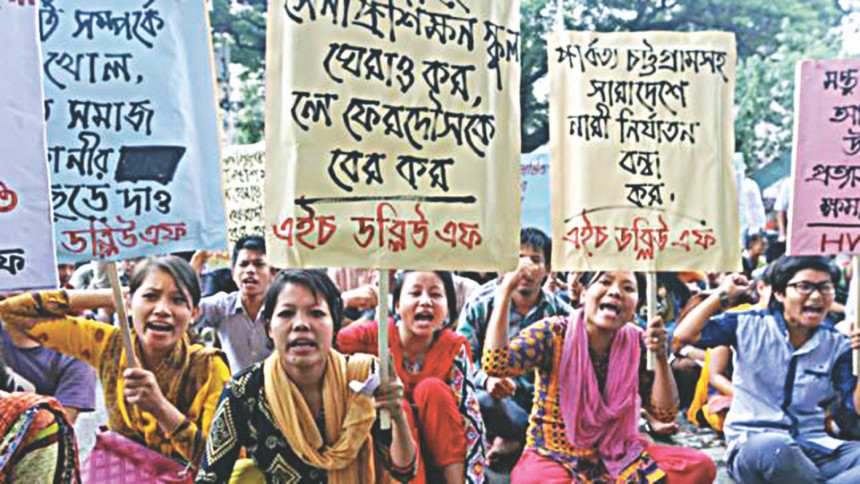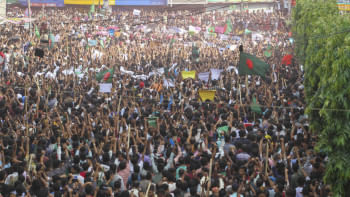No country for indigenous women

In the morning of June 10 this year, 30-year-old widow Sukhia Robidas was raped in her own home in Sutang Bazar of Habiganj and then chased down and beaten to death with a log by 35-year-old Shailu Mian when she tried to flee. On February 15, 2014, 30-year-old Sabita Chakma was also killed after being raped by four settlers when she went to collect grass for her cattle on the banks of Chengi River, Khagrachari. Cases of such violence against indigenous women like Sukhia of the Robidas community and Sabita of the Chakma tribe are commonplace but hard-pressed to be found in the news and demonstrate the lack of secuity of indigenous women in their everyday lives.
“In Bangladesh, women are disadvantaged compared to men. Indigenous women are further marginalised than Bengali women, thus making indigenous women the most disadvantaged group in the country,” states Rani Yan Yan, queen of the Chakma Circle, at a discussion on indigenous women's rights. Indigenous women are especially prone to discrimination and sexual and gender-based violence on account of their gender, ethnicity, religion and socioeconomic status.
Worldwide, indigenous people account for less than five percent of the world's population, but make up 15 percent of the poorest, according to the UN. This statistic is characteristic of the exclusion indigenous peoples, especially women, face. Though the rights of the indigenous peoples are not one of the 17 Sustainable Development Goals (SDGs), the rights of indigenous women are upheld through goal five (gender equality)–which calls for the empowerment of all women and girls.
As a UN member state, Bangladesh has committed to the realisation of the 2030 Agenda for Sustainable Development and SDGs. The SDGs were launched with the commitment to “leave no one behind”, with a key lesson learned from the MDGs being that vulnerable groups such as indigenous women face double discrimination and so, saw the least progress. However, indigenous peoples, particularly women and girls, are still behind in the progress of the SDGs as a result of suffering from disproportionate violence and exclusion at the national level.
Violence against indigenous women and girls
Findings of the Kapaeeng Foundation, an indigenous rights' organisation, showed that between the years 2013 and 2017 (till June), there have been a total of 364 cases of human rights violations of indigenous women and girls. The most number of cases were of physical assault (106), followed by rape (100) and attempted rape (66). Between January and June of this year alone, 10 indigenous women and girls have been raped, three others were murdered after rape, eight were victims of attempted rape, and six were sexually harassed. These are only the documented cases.
According to the Kapaeeng Foundation's 2016 Human Rights Report on Indigenous Peoples in Bangladesh, 85 percent of the perpetrators in the 53 documented cases of violence against indigenous women and girls that year were non-indigenous people. The report also noted that two percent of the perpetrators were members of law enforcement agencies.
The findings also showed that the number cases of violence against indigenous women and girls have been falling over the last few years–down from 122 in 2014 to 85 in 2015 and finally to 58 in 2016. However, Barrister Sara Hossain, honorary executive director of BLAST, points out that this may not be a reduction in cases of abuse but rather indicative of underreporting of such cases to the authorities.
Lack of access to medical and legal services in remote areas and language barriers, among other challenges, combine to deter indigenous women and girls from reporting cases of violence against them. “Even among those filed, how many of those cases are going to completion? Are indigenous women and girls receiving adequate treatment, compensation and rehabilitation?” asks Hossain.
Exclusion at the national level
At the national level, there is a need for sex-disaggregated and ethnicity-disaggregated data on sexual and gender-based violence against women and girls, notes Yan Yan. Only then can the disproportionate violence faced by indigenous women and girls be measured and highlighted. There is also no separate allocation for indigenous women in Bangladesh's Gender Budget 2016-2017.
Bangladesh is part of the 2017 Voluntary National Review (VNR) of the UN High Level Political Forum to assess the country's progress in implementing the SDGs. However, indigenous women's groups were not at the table, though wide consultation was called for. “Their issues were not likely to have been brought up,” says Yan Yan.
Yan Yan adds that the lives of indigenous women are intricately attached to the environment, which goals 13, 14 and 15 of the SDGs address. “Thus, our involvement in the VNR is essential. So far, indigenous organisations have been involved in SDG implementation discussions, but no indigenous women's groups have been involved yet.”
According to Hossain, indigenous women have not only been excluded by the government but also by civil society organisations. “Present laws do not reflect indigenous women's experiences. There are no provisions for them in court–a lack of translators for example. This is also a failing of ours [civil society organisations].”
“Deliberate exclusion of indigenous people, especially women, is increasingly representative of a culture of conformity in Bangladesh today,” according to Khushi Kabir, coordinator of Nijera Kori and member of the International Chittagong Hill Tracts (CHT) Commission. Kabir says that a particular orthodox Islam has taken hold and is marginalising other sects and entire religions.
Across different social and economic indicators, indigenous women are particularly disadvantaged. According to Dr. Debapriya Bhattacharya, distinguished fellow of the Centre for Policy Dialogue and convenor of the Citizen's Platform on SDGs, “Whether in terms of the poverty line, nutrition levels, or education attained, indigenous women were found to be the furthest behind.”
Dr. Bhattacharya attributes this state of indigenous women to three main factors–discrimination against women, communal aggression and national negligence. The last point, for example, was clear in the case of the deaths of 10 children in Tripura Para, Sitakunda last month. Cause of death was found to be measles but what proved equally fatal was that the children were unvaccinated and suffering from malnutrition in an area out of the purview of government healthcare coverage.
Duplicity exists in Bangladesh, asserts Dr. Bhattacharya, where a good face is shown at international platforms but issues such as the inclusion of indigenous peoples in SDG implementation are not addressed domestically. “This cannot continue or the SDGs will not be successful in Bangladesh.”
Indigenous women fight for their rights on two levels–as minorities and as women. “We, the indigenous peoples, have been fighting year-round for social change,” says Jyotirindra Bodhipriya Larma, president of the BIPF and chairman of the CHT Regional Council. The fight for the rights of indigenous women needs to be included as a part of the larger battle for women's rights and against gender-based discrimination and violence in Bangladesh.


 For all latest news, follow The Daily Star's Google News channel.
For all latest news, follow The Daily Star's Google News channel. 



Comments